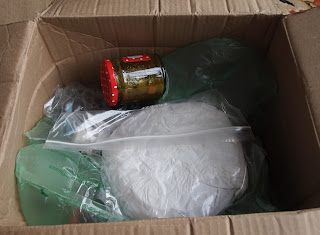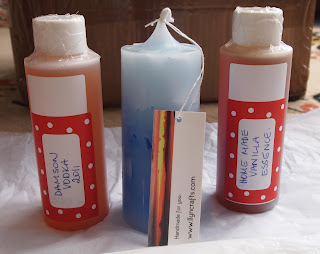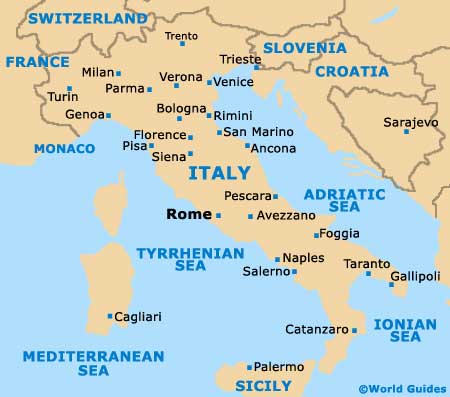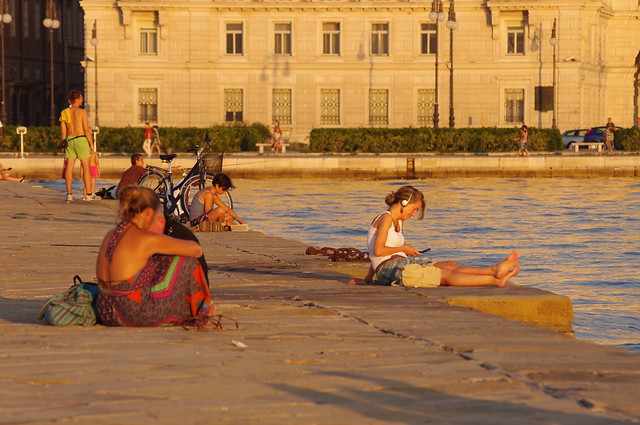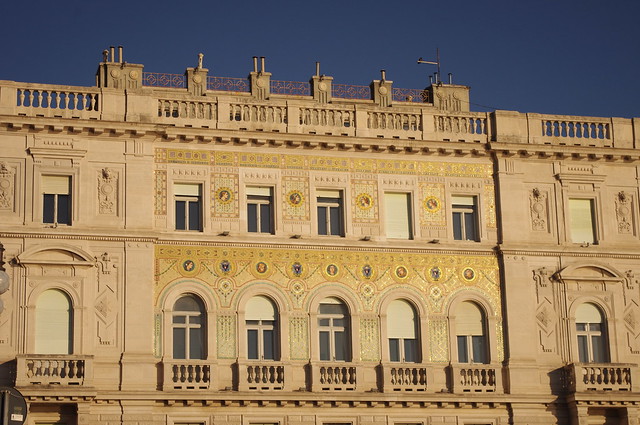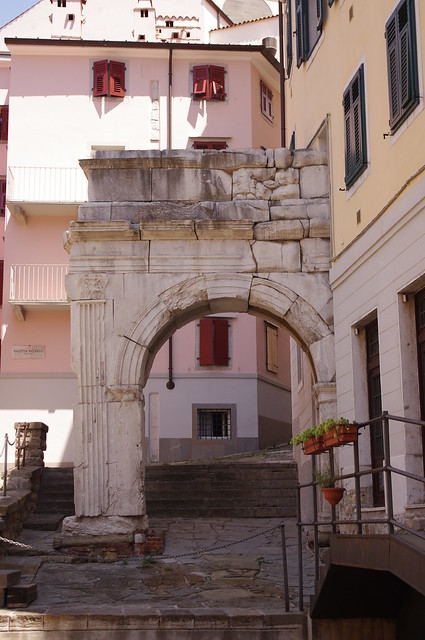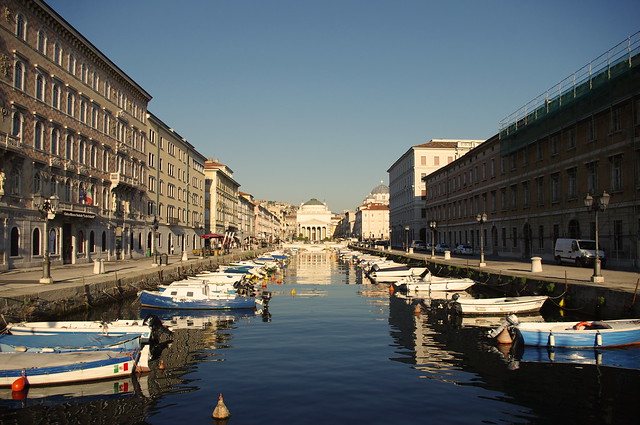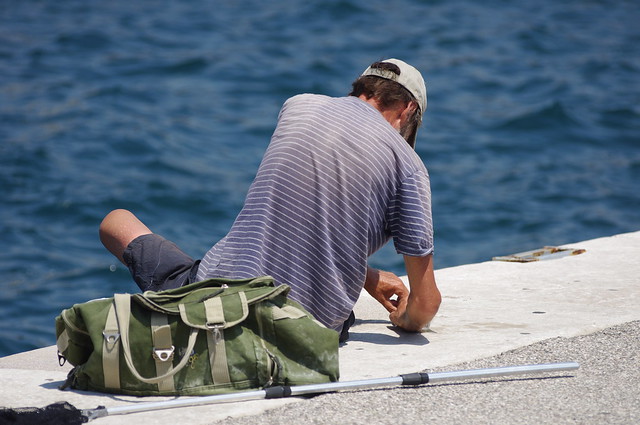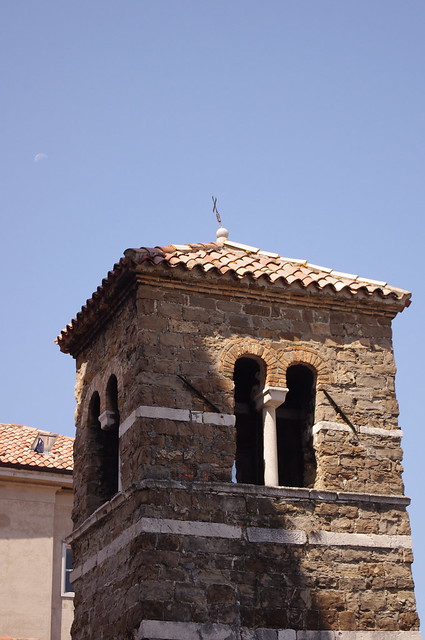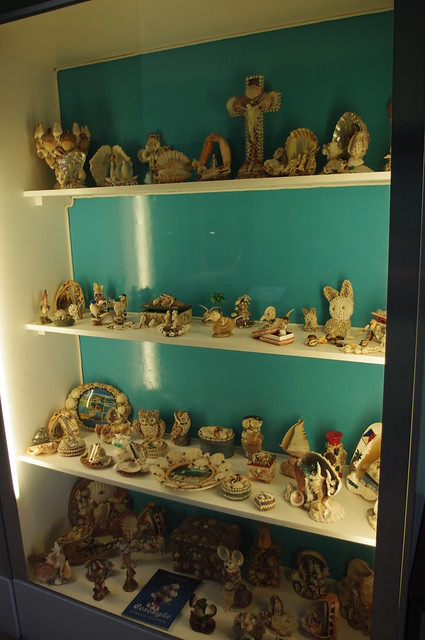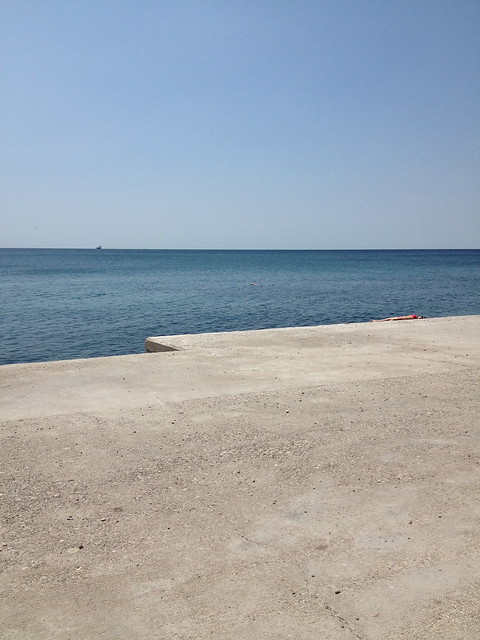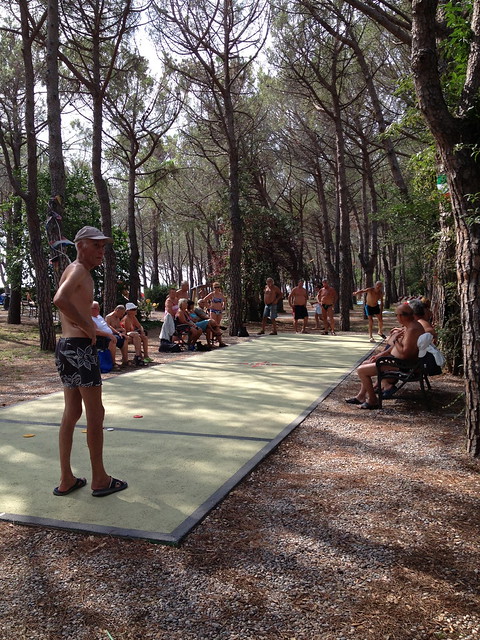The "Food & Drink" section of the Lonely Planet's guide to Italy begins, "Let's be honest: you came for the food, right? Wise choice." Well, I
didn't go for the food--I went for the sun and warm temperatures--but that sure didn't stop me from eating my way around Trieste. Sun and warm temperatures usually dampen my appetite, because who wants to eat a plateful of hot food when it's 90 degrees outside? Luckily, though, all the walking I did each day seemed to keep my metabolism up, such that even if I wasn't in the mood for a big lunch, I could easily indulge in one of Italy's famous multi-course meals come dinnertime.
My first dish--unless you count the tepid panini that I had in the airport, which I'd rather just erase from my memory--was one of my all-time favorite things to eat: a bufala mozzarella salad, consisting of a stack of tomato and mozzarella slices topped with basil and surrounded by rocket (or arugula, for my American readers).

This lovely concoction, which I had never seen before in vertical format, was on offer at Spritz@Lunch, a restaurant that I chose pretty much at random while walking by Trieste's lovely Grand Canal. Sasha was dining at his conference venue and so I was on my own. Perhaps feeling sorry for me in my solo state, the fatherly waiter set up a waterside table just for me, then offered me his arm to lead me there. Later, seeing me snap a few photos while I waited for my meal, he insisted on borrowing my camera to take a couple shots of me. The lighting wasn't great and my camera is a little complicated for a novice (not to sound snooty), but here is the resulting portrait:
(I swear I'm not a hunchback; I'm just mimicking one)
As far as views go, you could definitely do worse.
For much of the week, I visited the local Spar in order to pick up quick and easy lunches. I have never thought very highly of British Spars--which are generally comparable to American 7-11s--but their continental counterparts are pretty snazzy. They had all sorts of salads, sandwiches, lunch meats, breads, pastas, and soups, plus a microwave in the front of the shop and a picnic area outside so you could prepare your meal after purchasing it and then dine al fresco. I discovered a delightful type of taffy called "fruit toffees," which are like banana-, orange-, and strawberry-flavored Starbursts, only bigger, softer, and more natural. I demolished one bag in Italy and brought back two more to work on in the UK; so far I've managed to restrain myself, but those things are addictive.
Sasha accompanied me on my next culinary outing, which was dinner at another randomly chosen restaurant along the Grand Canal--this time, the
Fratelli la Bufala ("Buffalo Brothers"). We ate quite late--how European of us!--and were seated outside, so all of my food photos are a bit dark. Hopefully the dim lighting will convey the experience of watching the distant sunset over the Adriatic, all the while having a gentle sea breeze play on our faces. (By the way, did I mention that I was wearing a sleeveless shirt and shorts during all of this, but never felt cold? That, my friends, is the definition of summer. Britain, take note.)
In true Italian style, Sasha started off with a pasta dish--specifically, spaghetti with clams. I, on the other hand, sampled another version of the bufala mozzarella salad, this time with cherry tomatoes instead of the regular full-sized variety.
For his main course, Sasha selected buffalo sausages accompanied by potatoes and greens. We assume that these were made from true buffalo meat--not bison, which we Americans tend to call "buffalo." If that is the case, it's the first time I've ever seen that particular species on a menu, though I guess it is not uncommon in Asia, where water buffalo abound.
I chose to go meatless for my main course, ordering a (giant!) plate of ricotta gnocchi covered with a tomato ragu. It tasted both rich and fresh, and I regretted having to leave quite a bit on my plate.
(Really, this could be just about anything, couldn't it? I should try my iPhone flash next time...)
Sasha finished off with a dessert, but the one that arrived at our table was either not the one that he ordered, or not the one that he
meant to order; we're not sure whether he or the waiter was responsible for the mistake. In any case, what he ended up with was some sort of traditional regional dessert consisting of kind of a thin fruit jam covered by a custardy cream and topped by little shortbread fingers. It was not remotely close to what Sasha had intended to get, but it was still pretty nice--not too heavy, not too big, and overall a pleasant way to end the meal.
The next evening was the big conference banquet, which was held in the San Giusto Castle. Because I'm not sure how many times in my life I will ever be able to say this, let me just reiterate the point:
I ate dinner in an Italian castle.
(The entrance to San Giusto Castle, which is located on a hill in the middle of town)
Unfortunately, the whole experience was rendered a bit awkward by the fact that we sat at a table with people that we didn't know, in a room full of other people that we didn't know. That's because neither Sasha nor I normally attend this conference, and it addresses a topic that neither of us really studies (or cares about, truth be told). To make matters worse, everyone else at our table came from the same Japanese institution; so, they all knew each other, and several of them seemed to speak little or no English. Those that did were quite friendly, but it was still a little weird.
I have to admit that the best part of this odd arrangement was watching the reactions of the Asian diners to the very European food. They seemed quite comfortable with our starter, which was fish carpaccio--similar, in many ways, to sushi. On the other hand, there was a clear dislike of the barley risotto, which I actually thought was quite tasty; several of the guests left large portions on their plates, and a couple did so after having only two or three bites.
(Mullet and salmon carpaccio with melon and tangerine, accompanied by a bit of toast and balsamic reduction)
(Zucchini and shrimp barley risotto, garnished with--oddly enough--lime rind)
I would have been quite happy to have finished my meal at this point, but we still had two courses to go. This is probably a good time to mention that even though the Italians are renowned for their lengthy, multipart meals, they don't actually eat like that all of the time--which is pretty obvious when you look around and see nothing but thin, fit people everywhere. As the Lonely Planet guide explains, this is a style of food consumption that is normally reserved for special occasions--such as my husband's cousin's wedding, at which something like 6-8 courses were consumed over a period of 12 hours. I feel full just thinking about that.
Our third course was deemed an improvement by our fellow diners, who ate the fish but tended to only pick at the mashed potatoes.
(Grouper/mullet with capers, cherry tomatoes, mashed potatoes, and a balsamic reduction)
Finally--thank God--we finished off with what the menu referred to as "
millefoglie with strawberries." In reality, the latter was lemon sorbet with a drizzling of strawberry syrup. This was
amazing and I could have eaten an entire bowl of it, regardless of how full I was. The
millefoglie tasted pretty nice, but was
such a hassle to eat; the layers were kind of a sticky sponge that tend to stick together, and our only utensil was a pointlessly tiny fork that was absolutely useless for cutting off bites.
Perhaps unsurprisingly, Sasha and I opted to walk home after the banquet rather than wait for the shuttle bus--we both needed to speed up our digestion a little and burn off some of the many calories that we consumed during dinner.
On our last full day in Trieste, we decided to visit restaurants that had been specifically recommended by the Lonely Planet guide. For lunch, we checked out Circus, which is described as follows: "A rather quirky hangout for sometimes over-serious Trieste, Circus lives up to its colorful name with a vaguely big-top decor mixed with old-time movie paraphernalia. It's a great lunch stop with its ample panini, huge bowls of salad, and a selection of nicely priced primi. The atmosphere's cool but not haughty."
(Basmati rice salad with pineapple, chicken, and cherry tomatoes--a dish I will have to try to recreate in my own kitchen)
Indeed, Sasha and I noted that the clients were mostly locals rather than tourists, and many were obviously well-known by the restaurant's staff. There was nothing wrong with the food, but it also wasn't off the charts; really, I think that people go to Circus in order to see familiar faces and be at a "cool" hangout. Also, it's right in the middle of the shopping and eating district, so it's in a very convenient location.
Our dinner choice was more successful, but definitely one of the most unusual meals I've ever eaten. To provide a little context, I should point out that Trieste is very far north and east; although it is definitely Italian now, it was, for a very long time, a part of the Austro-Hungarian empire. Thus, while you do find traditional Italian pasta and seafood dishes, the regional specialty is much more Germanic. Specifically, the big thing in Trieste is buffets that serve up meat--particularly pork--accompanied by sauerkraut, cheese, and/or beer. Normally this is not the sort of thing I would ever eat, but, as they say, "When in Rome..."

We performed our culinary experiment with buffets at Buffet Da Pepi, which the Lonely Planet describes as follows: "One of Trieste's signature buffets, Da Pepi has been concocting traditional boiled meats, cold cuts and beer since--oh--1897. All kinds of pork joints are produced here, served up with sauerkraut, hot mustard, and kren (a tangy horseradish)." Our waiter explained that they don't really have a menu; instead, they just bring a sampler and whatever side dishes you want--some combination of fried zucchini, potatoes, and/or sauerkraut. Sasha and I both nixed the sauerkraut (I'm adventurous, but not that adventurous--that stuff is disgusting in any country), but we ordered both of the other options.
Shortly thereafter, this is what the waiter delivered to our table:
(Oh my God.)
This was definitely one of the most disturbing things I've ever seen on a dinner table, mostly because the combination of meats and pig-shaped platter made me feel as though I was eating directly out of a dead animal. Not that that stopped me from gorging.
The thing closest to Sasha was, obviously, a hot dog, and it was very tasty. Underneath that--between it and the mustard--was, basically, sausage that wasn't in a casing. It was delicious, and I ate most of it by myself. The fat-marbled pink stuff in the middle was a combination of ham and thick-cut bacon; the ham was really tender, but I wasn't in love with the bacon because it had an awful lot of gristle, *shudder*. The brown stuff near the pig's "ear" was straight-up pork, which normally I avoid like the plague but which I actually liked in this instance; next to that, over the pig's eye, was more ham.

Before I get to the other two things on the plate--give me a minute to gather my courage--let me just take a moment to discuss the potatoes, which were possibly one of the best things I have ever put in my mouth. I don't know how these were prepared, but I need to find out. Basically, it looks like they took really soft and starchy potatoes and mashed them together with bacon and--I suspect--a
lot of bacon fat. It's really hard to improve on either bacon or mashed potatoes, but putting them together in a single dish pretty much does the trick.
One more side note: here is the
kren mentioned by the Lonely Planet guide. The waiter came and grated it fresh for us. I tried it several times but never really got much of that overwhelming spicy taste that I usually associate with horseradish; maybe I just wasn't eating enough, or maybe it was being overwhelmed by the mustard that was also on my meat. Incidentally, just as I normally don't eat pork, I also normally don't eat mustard; I really rocked the boat on this little outing.
Now, speaking of rocking the boat, it's time to get back to those last two cuts of meat on our plate. Sasha and I had absolutely
no idea what the brown thing was closest to the pig's front hoof, but we're pretty sure it was some sort of offal--perhaps tripe. There was no way that either of us was going to sample a piece of the piggy GI tract, so we just left that alone. The other thing--the dark red strip right on the pig's belly--was tongue. (It has just occurred to me that the food would have been a lot less mysterious if they'd arranged it on the plate in an anatomically correct fashion.)
Now, Sasha is a fan of beef tongue, but I have never eaten the tongue of any species, and have never felt compelled to do so. However, after much dithering and quite a lot of time spent sitting frozen with my loaded fork raised in front of my mouth, I did finally manage to force myself to try a piece. Shockingly, I survived. It wasn't bad. In fact, it was pleasingly tender, and other than that seemed pretty much like a piece of ham. I just have a real mental issue with eating tongue because I absolutely
hate biting my own tongue, and so I have this strange (and ridiculous) feeling of sympathy for the meat that I am eating. But I did it, so I can check that one off the bucket list (assuming it was ever there to begin with).
The only other culinary experience worth mentioning is our sampling of the many flavors of gelato on offer. There were several gelato trucks that roamed around town, including one that often parked up near the Piazzo Unita d'Italia:
(Three generations of gelato-lovers)
(Self-portrait of a strawberry gelato eater)
We visited one of these during our outing to the "beach," and I tried strawberry while Sasha had chocolate. We also stopped by a gelato specialty store called Grom, which is located near the--you guessed it--Grand Canal; there, Sasha tried apricot and raspberry, while I had lemon.
I'm not entirely sure why people are so obsessed with gelato (as opposed to, say, ice cream or frozen yogurt), because, as far as I'm concerned, all of the products in this genre are equally wonderful in their own ways. That said, the flavors I tried in Trieste were very light, fresh, and all-natural, so they were especially refreshing and summery...The perfect cure for all the cold and rain we've had on our plate for the last several months in Britain.
---
Consider this a little
taster (pun intended) of our trip to Trieste...a full blog post on the rest of our Italian adventures is on its way!



